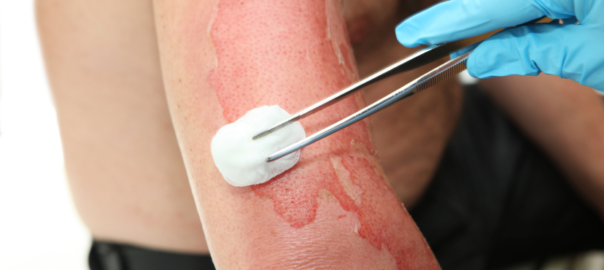People with Severe Burns May Benefit from Stem Cell Therapy

The skin is the human body’s first line of defense. Heat, electricity, caustic chemicals, radiation, and sunlight can all damage the skin with a burn injury. Scalding from steam or boiling liquids, fires, and flammable gasses and liquids are some of the most common causes of skin burns.
Depending on the severity of the injury, burns are classified as first degree (only the upper layer of skin is affected), second degree (the upper layer and the layer under it is affected), and third degree (deeper layers of the skin are damaged).
Burn injuries lead to blistering and swelling in the short term and scar formation in the long term. When serious burns occur, fluid loss from the skin can result in shock which may prove to be fatal. Infections in the injured skin can further complicate matters.
Conventional treatment of burns consists of plenty of fluids and good nutrition, antibiotics to prevent and treat infections, and in serious cases, skin grafting.
How can people with severe burns benefit from stem cell therapy?
Researchers have discovered that stem cells can help with muscle regeneration in patients who have suffered severe burns. Scientists at the University of Texas Medical Branch have been studying the effects of burns on muscle cells. They found that while the burn causes the death of muscle cells, the injury also induces satellite cells to regenerate muscle. Satellite cells are stem cells found in skeletal muscle.
Have other studies shown similar findings?
Yes. A group of researchers at the American University of Beirut in Lebanon, the George Washington University in Washington DC, and The National Institutes of Health in Bethesda, Maryland, found that stem cells have a beneficial therapeutic effect in healing burn wounds. Stem cells help re-epithelialize the skin by leading to the proliferation of keratinocytes (cells in the epidermis of the skin which manufacture keratin). Wound closure and angiogenesis (blood vessel formation) occurs more rapidly. Stem cells have been shown to decrease wound contraction and scar formation. There is less inflammation in the wound, and hair follicles are able to form in the sebaceous glands.
How can stem cells be applied to wound healing?
There are different ways to apply stem cells to a burn wound including topical application at the site of the injury, local injection, systemic injection, and dermal application with a carrier molecule.
What’s stopping stem cells from being used as standard treatment for burns?
Different studies have shown inconsistent results. This could be due to different amounts of stem cells being used or stem cells at different stages of replication being employed. While there has been a qualitative demonstration of benefit, the healing effect of stem cells has not yet been quantified. To prove that stem cells are a safe and effective treatment for burns, more studies under carefully controlled and optimal conditions need to be conducted. The safety of stem cell treatments must also be evaluated. There is a concern that stem cell treatment could result in uncontrolled growth or increased fibrosis in the skin.
References:
- https://www.nlm.nih.gov/medlineplus/burns.html
- http://www.ndtv.com/health/stem-cell-therapy-may-help-treat-patients-with-severe-burns-1425998
- http://www.hindawi.com/journals/bmri/2015/684084/
- Image courtesy of http://burninjuryguide.com/


